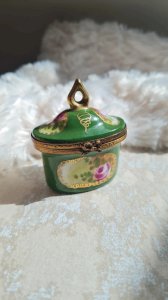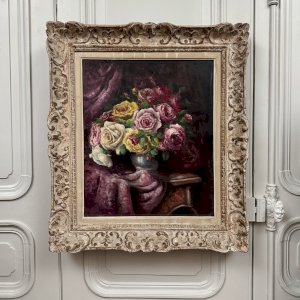- Sell Now
- Home
-
FURNISH
All STORAGE FURNITURE • Wardrobe • Chests of drawers, Chiffonnier • Sideboard • Shelves, Bookshelves • File cabinet • Sewing Furniture • Bar cabinet • TV Stand • Trunk, Chest TABLE & BEDSIDE TABLE • Dinner Table • Coffee table, side table, end table & Bedside • Console, Pedestal table & Selette • Serving Table, Trolley • Card Table • Draper's counter & table SEAT • Sofa • Armchair • Chair • Stool • Bench • Daybed • Beanbag & Footrest • Deckchair & Outdoor DESK, SECRETARY, DRESSING TABLE GARDEN LOUNGE BEDDING • Bed • Bedhead • Cradle, Moses basket CRAFT FURNITURE, WORKSHOP • Workbench • Stool, Ladder, Step • Easel & Trestle SCREEN PIANO
-
DECORATE
All TO PUT • Sculpture, Statuette • Vase & Planter • Dame Jeanne, Bonbonne & Flacon • Bridal globe, Dome • Pin tray, Ashtray • Candlestick & Candle • Photo frame • Stone, Fossil, Mineral • Earth Globe MIRROR WALL DECORATION • Painting • Engraving & Illustration • Poster • Tapestry • Wall Frame • Plate & Sign • Juju Hat & Wall Paniel • Mask • Hunting Trophy • Other object to hang CLOCK, PENDULUM & ALARM CLOCK ARRANGEMENT • Jar, Box & Case • Basket, Wastebasket & Crates • Magazine Rack & Vinyl Holder • Display & Spinner • Coat hook & Coat rack • Furniture Valet & Mannequin • Towel Holder • Suitcase & Travel Bag • Bottle Rack • Umbrella holder BATHROOM OFFICE • Mail holder • Bookends • Sulphide & Paperweight • Stationery FIREPLACE ACCESSORIES HOBBIES • Vintage Sport • Music • Vintage device • Smoking Item • Militaria, Ancient weapon • Miniature Vehicle • Game, Playing Cards • Collection object & Curiosity BIRD CAGE RELIGION, SPIRITUALITY
- TEXTURE
- ILLUMINATE
-
ACCOMODATE
All TABLE & SERVING • Plate • Silverware • Knife Holder • Glass • Bowl, Mug, Cup • Bowl, Ramekin & Cup • Dish, Cup & Salad Bowl • Tray, Basket & Server • Table Mat • Pitcher, Carafe, Bottle, Tea & Coffee Jug • Ice Bucket • Salt & Pepper shakers, Oil & Vinegar shakers • Sugar and jam maker • Gravy boat • Butter dish • Egg cup • Terrine OLD BALANCE CUTTING BOARD GRINDER CASSEROLE, SAUCEPAN & PAN KITCHEN UTENSIL & ACCESSORY
- TINKER
- KIDS
- Jewelry & Accessories
Login
Related Products
Description
PERFUME BURNER PILOT IGNITER ROBJ EAN BORN LIMOGES WG CIE CHINOIS BRONZE FRANCE (B1156) Limoges porcelain ROBJ with Chinese decoration with bronze.Probably a perfume burner, a pilot light or an igniter.You will notice that it is broken on its heightEAN BORN - ROBJ In 1908 , the entrepreneur Jean Born creates the ROBJ house and gives it this name, from the letters of his own surname and in the form of an anagram. In 1910, he deposited the models of his electric igniters. Two years after the First World War, he renewed the operation by incorporating all kinds of artistic porcelain trinkets. The business went smoothly, without clashes or particular success. However, in 1922, Jean Born died in an automobile accident and Lucien Willemetz, shareholder of the company, took over the management, following which the house of ROBJ took off. . In fact, he surrounded himself with sculptors, modelers and fire technicians, a veritable breeding ground for talent until 1931. At the Decorative Arts exhibition of 1925, the company, rich in a new fantasy, came out of anonymity and gets a bronze medal. Most of the activity is now devoted to publishing humorous, utilitarian and frequently anthropomorphic trinkets, whose colorful shapes are inspired by Cubism. In order to encourage quality artists to work for the company, in 1927 this one sponsors a competition of “ceramic art trinkets”, whose jury is made up of excellent potters and sculptors. Among them, we can cite Pompon, Landowski and Dufrène, but also references in the field of the arts, including the curator of the Galliera museum and the administrator of the Mobilier national. Three cash prizes are awarded, of 5,000, 3,000 and 2,000 francs. The following year, the jury received no less than 170 submissions! ROBJ's awards and reputation drive many artists to showcase models. One of the most important animal producers of the moment, Charles Lemanceau, was awarded a prize in 1929 for a life-size sculpture of a woman (1.64 m), produced in celadon green ceramic. Among the six hundred models referenced to date, nearly a hundred are attributed to him. In 1928, Willemetz innovated again by presenting curious liqueur bottles, combining charm and humor with a stylization totally in phase with the time, and which collectors still argue today. The burlesque creativity of these pieces associated with the function for which they are intended contribute to an immediate success. A Burgundian for the crème de cassis, a magistrate for the marc de champagne, a traveler for the gin, but also five stout figures for the five pieces of a service of jars of cream, or even pear-shaped heads, apple or cherry as the lids of jam jars ... the imagination dominates, and pleases. In the same cheerful and inventive spirit, Willemetz introduced tobacco jars in 1929. But ROBJ also produces purely decorative ceramic figurines, characters and animals, specific to the crackle fashion of the 1930s. Elegance, modernity and originality are omnipresent and the mixture of themes or subjects contributes to the success of the company. Very popular today - including the famous bonbonnières - these trinkets were in reality from their creation. In December 1927, the critic Paul Sentenac wrote in an article entitled "The renaissance of French art and luxury industries", that these small decorative statuettes are in great demand by "our refined compatriots and by foreigners passionate about things from home. we". As part of a totally commercial and modern approach, the ROBJ house publishes a Catalog of artistic novelties in ceramics and artistic glassware, intended for professionals. In addition, it employs representatives and uses advertising, not hesitating to proclaim: "The trinkets signed ROBJ are the complement of any elegant interior, on sale in all the houses of elegance." Or again: “ROBJ trinkets are in our modern times what porcelain from Saxony and Sèvres were in the 18th century.” The photos are part of the description.Dimension: Height: 11 cmDiameter: 11cmJereste at your disposal for any questions .
Réf :
#15696
Color(s) : Multicolored
Comments
Related Products
Description
PERFUME BURNER PILOT IGNITER ROBJ EAN BORN LIMOGES WG CIE CHINOIS BRONZE FRANCE (B1156) Limoges porcelain ROBJ with Chinese decoration with bronze.Probably a perfume burner, a pilot light or an igniter.You will notice that it is broken on its heightEAN BORN - ROBJ In 1908 , the entrepreneur Jean Born creates the ROBJ house and gives it this name, from the letters of his own surname and in the form of an anagram. In 1910, he deposited the models of his electric igniters. Two years after the First World War, he renewed the operation by incorporating all kinds of artistic porcelain trinkets. The business went smoothly, without clashes or particular success. However, in 1922, Jean Born died in an automobile accident and Lucien Willemetz, shareholder of the company, took over the management, following which the house of ROBJ took off. . In fact, he surrounded himself with sculptors, modelers and fire technicians, a veritable breeding ground for talent until 1931. At the Decorative Arts exhibition of 1925, the company, rich in a new fantasy, came out of anonymity and gets a bronze medal. Most of the activity is now devoted to publishing humorous, utilitarian and frequently anthropomorphic trinkets, whose colorful shapes are inspired by Cubism. In order to encourage quality artists to work for the company, in 1927 this one sponsors a competition of “ceramic art trinkets”, whose jury is made up of excellent potters and sculptors. Among them, we can cite Pompon, Landowski and Dufrène, but also references in the field of the arts, including the curator of the Galliera museum and the administrator of the Mobilier national. Three cash prizes are awarded, of 5,000, 3,000 and 2,000 francs. The following year, the jury received no less than 170 submissions! ROBJ's awards and reputation drive many artists to showcase models. One of the most important animal producers of the moment, Charles Lemanceau, was awarded a prize in 1929 for a life-size sculpture of a woman (1.64 m), produced in celadon green ceramic. Among the six hundred models referenced to date, nearly a hundred are attributed to him. In 1928, Willemetz innovated again by presenting curious liqueur bottles, combining charm and humor with a stylization totally in phase with the time, and which collectors still argue today. The burlesque creativity of these pieces associated with the function for which they are intended contribute to an immediate success. A Burgundian for the crème de cassis, a magistrate for the marc de champagne, a traveler for the gin, but also five stout figures for the five pieces of a service of jars of cream, or even pear-shaped heads, apple or cherry as the lids of jam jars ... the imagination dominates, and pleases. In the same cheerful and inventive spirit, Willemetz introduced tobacco jars in 1929. But ROBJ also produces purely decorative ceramic figurines, characters and animals, specific to the crackle fashion of the 1930s. Elegance, modernity and originality are omnipresent and the mixture of themes or subjects contributes to the success of the company. Very popular today - including the famous bonbonnières - these trinkets were in reality from their creation. In December 1927, the critic Paul Sentenac wrote in an article entitled "The renaissance of French art and luxury industries", that these small decorative statuettes are in great demand by "our refined compatriots and by foreigners passionate about things from home. we". As part of a totally commercial and modern approach, the ROBJ house publishes a Catalog of artistic novelties in ceramics and artistic glassware, intended for professionals. In addition, it employs representatives and uses advertising, not hesitating to proclaim: "The trinkets signed ROBJ are the complement of any elegant interior, on sale in all the houses of elegance." Or again: “ROBJ trinkets are in our modern times what porcelain from Saxony and Sèvres were in the 18th century.” The photos are part of the description.Dimension: Height: 11 cmDiameter: 11cmJereste at your disposal for any questions .
Réf :
#15696
Color(s) : Multicolored
 English
English  Français
Français 




























